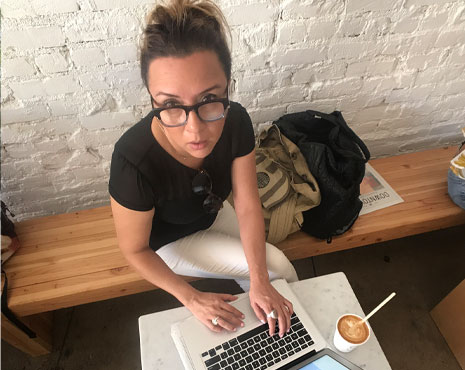Do you wonder why anxiety seems to be on the rise, gripping the lives of so many?
I meet people dealing with different levels of worry every day.
They come to me because something is making their anxiety worse.
It could be a mix of work and personal life…
Feeling stuck with a big decision…
Trouble in relationships…
Or just feeling unsure about the future.
And don’t get me started on social media and comparing yourself to others.
These things stir up Anxiety.
Learning to recognize and label our emotions is akin to arming ourselves with internal tools and skills to manage them more effectively.
Now, let me clarify something—anxiety, in and of itself, is neither good nor bad. In fact, a dash of anxiety can be just the kick in the pants we need to propel us into action.
Picture yourself lounging on the couch all day—without a hint of anxiety, would you ever get anything done?
However, what we do not need is the kind of anxiety that wraps its icy tendrils around our hearts, rendering us immobile, afraid to take risks, make decisions, or embrace the unknown.
The one that keeps us from loving and creating a fulfilling life!
In this post, I will give you the tools to not only identify anxiety but also to recognize the insidious thinking traps that amplify its intensity.
What exactly is anxiety?
First things first, what exactly is anxiety? At its core, anxiety is the body’s natural response to stress, a survival mechanism that kicks into gear when we perceive a threat, whether real or imagined.
It’s that flutter of unease in the pit of your stomach, the racing heartbeat that echoes in your ears, the nagging voice in the back of your mind whispering tales of impending doom.
But here’s the thing, anxiety isn’t always the villain in our story. In small doses, it can be our faithful companion, nudging us out of our comfort zones and spurring us into action. It’s what compels us to double-check that we turned off the stove or to meticulously prepare for that important presentation.
However, when anxiety begins to overshadow our lives, casting a shadow over every thought and action, that’s when it becomes a beast of burden. It’s like being trapped in a labyrinth of fear and uncertainty, with no clear path forward.
How to recognize anxiety?
Here are some tips on how to recognize unhealthy levels of anxiety:
- Pay attention to physical cues like rapid heartbeat, sweating, or shallow breathing.
- Notice changes in behavior, such as avoiding certain situations or becoming easily irritable.
- Keep an eye on racing or intrusive thoughts that disrupt your daily activities.
- Monitor your emotions—feeling overwhelmed, restless, or constantly on edge may indicate anxiety.
- Recognize patterns of worry or fear that seem disproportionate to the situation.
- Seek professional help if you experience persistent symptoms impacting your quality of life.
Or normal level of anxiety:
- Feeling a slight nervousness before a significant event, like a job interview or a public speaking engagement.
- Experiencing a moderate level of anxiety when faced with a challenging task or new situation, motivates you to prepare and perform your best.
- Feeling a sense of excitement or anticipation before engaging in something new or unfamiliar.
- Experiencing occasional worries or concerns about future events, but being able to manage them effectively and move forward with confidence.
- Having a healthy level of vigilance in potentially risky situations, helps you stay safe and make informed decisions.
- Feeling a reasonable amount of stress during times of change or transition, but being able to adapt and cope effectively.
- Experiencing some anxiety in social situations or when meeting new people, but still being able to engage and connect with others comfortably.
In essence, anxiety is both friend and foe—a delicate balance between caution and chaos, uncertainty and understanding.
What are “Thinking Traps”?

Now, let’s talk about those sneaky thinking traps that amplify our anxiety.
Imagine you’re caught in a web of negative thoughts, each twist and turn trapping you more. These thinking traps are like tricky traps set to catch you with promises of safety, but end up leaving you feeling very sad and stuck.
Don’t worry, because you can unlock these traps and free yourself. One powerful tool is to challenge those thinking traps.
Here are the most common traps, can you resonate with any of them?
Catastrophizing
Ah, the art of turning molehills into mountains. When faced with a challenge, your mind tends to conjure catastrophic scenarios, painting the future in shades of doom and gloom. But pause for a moment and ask yourself: Is this truly the end of the world, or merely a bump in the road?
Challenge those catastrophic thoughts with a dose of reality and watch as the mountains shrink back into molehills.
Mind Reading
Ever find yourself convinced that everyone is silently judging you, casting scornful glances your way? It’s like starring in a twisted Shakespearean drama where the audience is composed entirely of your inner critics. But here’s the kicker: most of the time, people are too caught up in their own drama to spare a second thought for yours.
Challenge those mind-reading tendencies by embracing the uncertainty and letting go of the need for constant validation.
All-or-Nothing
The black-and-white world of extremes. You’re either a soaring eagle or a lowly worm, with no room for shades of gray. But life is a kaleidoscope of colors, each hue adding depth and richness to the tapestry of existence.
Challenge those all-or-nothing thoughts by embracing the beauty of nuance and celebrating the shades in between.
Personalization
The fallacy of personalization can lead you to believe that everything happening around you is a direct result of your actions, or that everything is your fault. This self-centered way of thinking can burden you with undue guilt and stress. It’s important to remember that you’re not the pivot around which the universe spins. Challenge this by recognizing that other factors and other people’s actions also influence outcomes.
Emotional Reasoning
You may often find yourself using your current emotions as evidence of the truth: “I feel it, therefore it must be true.” This trap convinces you that if you feel incompetent, then you must be incompetent, or if you feel unloved, then nobody loves you. Challenge this by separating feelings from facts, reminding yourself that feelings are just passing states that don’t necessarily reflect reality.
How to Manage Anxiety
Now that you’re more aware of what anxiety looks like and the thinking traps that can exacerbate it, let’s discuss some strategies to manage it effectively. The goal isn’t to eliminate anxiety completely but to control it so it doesn’t control you.
Mindfulness and Meditation
Practicing mindfulness can help you stay grounded in the present moment, reducing the impact of anxiety. Meditation, whether through guided sessions or personal practice, can significantly lower stress levels and help you maintain a calm state of mind.
Physical Exercise
Regular physical activity is a powerful stress reliever. It not only improves your overall health but also boosts your mood and can act as a natural anxiety reliever. Whether it’s a brisk walk, a jog, or a yoga session, find an activity that you enjoy and make it a part of your routine.
Healthy Sleep Habits
Anxiety can wreak havoc on your sleep patterns, but a good night’s sleep is crucial in managing stress and anxiety. Establish a relaxing bedtime routine, avoid screens before bed, and try to keep a consistent sleep schedule.
Cognitive Behavioral Therapy (CBT)
CBT is a highly effective treatment for anxiety, focusing on changing negative thought patterns that cause or worsen anxiety symptoms. Working with a therapist can help you develop coping strategies to manage and reduce your anxiety.
Social Support
Connecting with friends and family can provide a significant emotional lift and reduce your anxiety. Being part of a community gives you a sense of belonging and security, which can help you cope with stressful situations.
Journaling
Writing down your thoughts and feelings can be a therapeutic activity. It allows you to express what’s on your mind and clarify your thoughts, which can help reduce anxiety.
Conclusion
Anxiety is a complex but manageable condition that affects many people. By understanding its nature and recognizing the symptoms and thinking traps, you can take practical steps to manage and reduce its impact on your life.
Remember, it’s about balance and finding the strategies that work best for you to maintain mental health and lead a fulfilling life.
Images: Alexander Krivitskiy, Yasin Fotohi


![Unlocking the Power of Self-Love [The New Valentine]](https://andreabahamondes.com/wp-content/uploads/2024/02/unlocking-the-power-of-self-love-andrea-bahamondes-1-400x250.jpg)


0 Comments